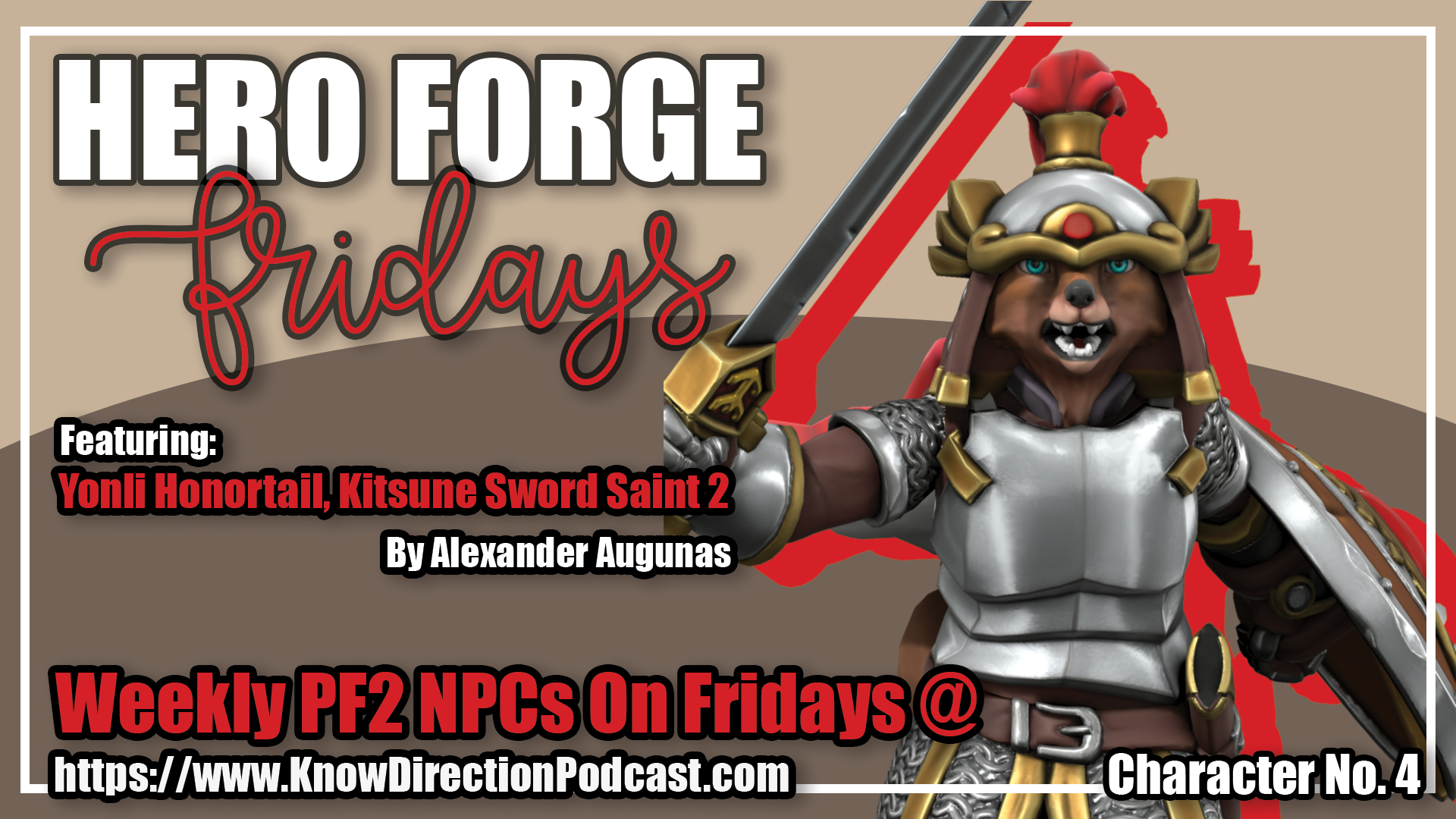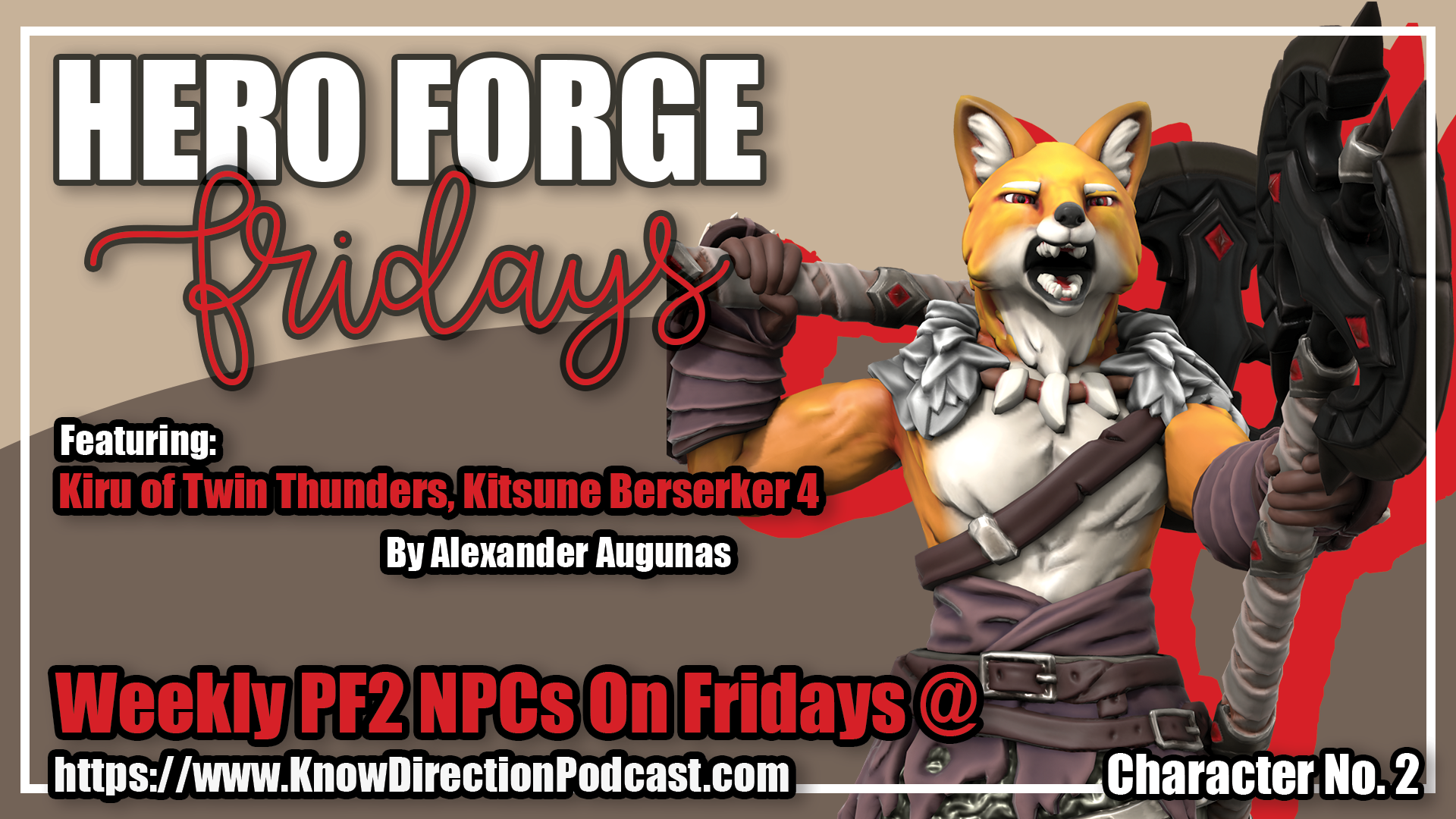Welcome to Guidance, Private Sanctuary’s source for tips and techniques for the Pathfinder Roleplaying Game, written by Everyman Gamer Alexander Augunas. Today, we’re going to be looking at Alex’s Emerald Spire character, Kenzo Shimjuko!
It’s the Friday before my birthday, and you know what that means; ALEX’S BIRTHDAY ICONIC DESIGN!
This one, folks, has been REALLY difficult to sit on. Back in February, the Know Direction crew (Ryan, Perram, Tina, Cathy, Anthony, Jeff, and myself) all decided to commit to running the Emerald Spire together. But not just that, we would all take turns GMing the spire, the GM using their credits to keep their Emerald Spire character at the same level as the rest of the group. (This would change slightly, as Jeff is a butt and has played a large chunk of levels, so he’s going to be GMing most of the floors for us.)
Now, of course, I knew that the entire party was going to expect me to play a kitsune, and I didn’t want to disappoint them in that regard. But just what I decided to play, however, was something that I COULD mess with expectations a bit. I had a hunch that my group might have been expecting me to play some sort of powerhouse crazily built character, so I didn’t do that. Instead, I built the one thing that NO ONE ever brings to the table, and when we sat down and played our game I happily discovered that I was right. Because NO ONE ever brings a skill monkey to the table.
And I was prepared to skill monkey it up.
Build Concept
So I wanted to make the most effective skill monkey that I could. Ready to see what I came up with?
- Swashbuckler (Inspired Blade): This was my first level for a few reasons. First, I knew that I wasn’t going to be investing at all in Strength, and I wanted Dex to damage at 1st level. The inspired blade is the best way to do this; I got Weapon Focus and Weapon Finesse for free from my swashbuckler levels and took Fencing Grace as my first level feat. The second reason is panache; inspired blades don’t get panache for killing folks (rapier crits only), but they get an amount of panache equal to their Charisma plus their Intelligence. The final reason was the deeds; I knew that with the right deeds, I could keep myself alive VERY effectively, as the inspired blade doesn’t trade any of the initial deeds. I can parry, dodge, and derring do, huzzah!
- Investigator (Empiricist, Sleuth): This is my bread-and-butter class, the class that I would be focusing on after I finished dipping. I took this at 2nd Level to start because I REALLY wanted to make sure that I got trapfinding, however. Sleuth is generally a reviled option, but with my multiclassing I took it because of how luck and panache interact; in short, they’re combined together into one big pool. Effectively, my lucky panache pool has a number of points equal to double my Charisma plus my Intelligence, both of which, as you may have guessed, are substantially good. Empiricist kicks on at 2nd level, where it allows me to use my Intelligence for a number of skills instead of their usual ability score. The big two on that list are Perception and Sense Motive, which is nice because my Wisdom isn’t great.
- Rogue (Kitsune Trickster): It honestly doesn’t matter much if I upgrade to the Unchained Rogue or not, as I’m only ever going to use one weapon, which is finessable by both classes. That said, I took this dip for kitsune trickster, which allows me to add my Intelligence to my Bluff, Diplomacy, and Intimidate checks. So again, both of my best ability scores to several key skills.
The net result of all this is that my character has a wicked number of skill points, inspiration, and uses his Charisma and/or Intelligence for ALL of his key skills. Let’s take a look at how this build plays out now!
Early Levels (1–7)
- Classes: swashbuckler (inspired blade) 1, investigator (empiricist, sleuth) 5, rogue (kitsune trickster) 1
- Feats: Fencing Grace (1st), Combat Reflexes (3rd), Extra Investigator Talent: expanded inspiration (5th), Bodyguard (7th)
- Abilities: ceaseless observation, deeds, inspired finesse, inspiration, inspired panache, investigator talent (expanded inspiration, perceptive tracking, trap spotter), keen recollection, kitsune’s guile, sleuth’s luck, sneak attack +1d6, studied combat, studied strike +1d6, trap sense +1, trapfinding, unfailing logic +2
So, why’d I pick what I picked? Well, Combat Reflexes was to take advantage of opportune parry and riposte; its only an action to riposte, not parry, so I figured that grabbing this feat would expand my ability to be defensive, which is exactly what I wanted to work on. There are plenty of good investigator talents, mostly the ones that play off of inspiration some way, and since I had Combat Reflexes, I decided that I wanted Bodyguard too so I could help the characters who are going to get punched in the face often. (Hint: Danjo) That feat is still very much up in the air, however.
Not having alchemy hurts a little, but the true strength of the sleuth archetype is in the form of its make it count deed, which allows you to spend a point of panache in order to apply an investigator talent that you don’t have to an attack made during your studied combat. Normally this might be too expensive panache-wise to be effective, but my panache pool is MASSIVE; I honestly don’t care if I burn panache, a semi-reusable result, stacking nasty debuffs on enemy. Everything from rolling high on an inspiration die or a Knowledge or Sense Motive check to critting with a rapier gives me panache back, so as long as I’m doing what I’m good at, I expect to be getting panache every now and then. I also picked trap spotter, because forget having to check every individual square in every layer of the Emerald Spire. Level 5 can’t come soon enough!
Overall, I’m pleased with how my character looks at the beginning of Emerald Spire; let’s check in on him at the next stage of the game.
Mid Levels (8 –14)
- Classes: swashbuckler (inspired blade) 1, investigator (empiricist, sleuth) 12, rogue (kitsune trickster) 1
- Feats: Fencing Grace (1st), Combat Reflexes (3rd), Extra Investigator Talent: expanded inspiration (5th), Bodyguard (7th), Inspired Strike (9th), Extra Investigator Talent: inspired intelligence (11th), Extra Inspiration (13th)
- Abilities: ceaseless observation, deeds, inspired finesse, inspiration, inspired panache, investigator talent (amazing inspiration, combat inspiration, expanded inspiration, inspired intelligence, perceptive tracking, trap spotter, underworld inspiration), keen recollection, kitsune’s guile, sleuth’s luck, sneak attack +1d6, studied combat, studied strike +5d6, trap sense +4, trapfinding, unfailing logic +4
Feat-wise, my build requires that I start picking up some more helpful inspiration-themed abilities, namely the talents that make my inspiration free for my most commonly used skills. In doing this, I’m hoping that I can afford to use Inspired Strike and combat inspiration as often as possible, helping my ability to hit and deliver my debuffs via panache. Another option that I’m considering is picking up Shadow Strike so my investigator precision damage isn’t nullified by all the darkness we’re going to be assured to fight in under ground, but that’ll need more assessment before I decide.
Another power I get is this neat ability that gives my character benefits against illusions, eventually becoming flat-out immune to them at high levels. Its not a super powerful ability, but giving me the ability to use my Intelligence instead of my Wisdom on a Will save against an illusion is nothing that I will EVER say no to, given my Intelligence and Wisdom scores.
Many people criticize this archetype for trading alchemy this build fights like any other melee character; almost like a rogue with a lot of weird use per day abilities. But by the end of this level bracket, I’ve managed to take a huge number of skills and make them free to use with inspiration; I’ve managed to afford this because of my ability to spend panache points for more talents in a fight. I have some great options for expanding my attack bonus, buffing my allies, and hampering my foes. I think I’m ready to move on to the end game.
Endgame (15+)
- Classes: swashbuckler (inspired blade) 1, investigator (empiricist, sleuth) 18, rogue (kitsune trickster) 1
- Feats: Fencing Grace (1st), Combat Reflexes (3rd), Extra Investigator Talent: expanded inspiration (5th), Bodyguard (7th), Inspired Strike (9th), Extra Investigator Talent: inspired intelligence (11th), Extra Inspiration (13th), Extra Inspiration (15th), Extra Inspiration (17th), Extra Inspiration (19th)
- Abilities: ceaseless observation, deeds, inspired finesse, inspiration, inspired panache, investigator talent (amazing inspiration, combat inspiration, effortless aid, eidetic recollection, expanded inspiration, inspired intelligence, perceptive tracking, quick disable, tenacious inspiration, trap spotter, underworld inspiration), keen recollection, kitsune’s guile, sleuth’s luck, sneak attack +1d6, studied combat, studied strike +8d6, trap sense +6, trapfinding, unfailing logic +4
Now, only the 15th level of this build will likely be used in the Emerald Spire (assuming that I even live that long), but I filled out the rest of the build for fun. I don’t have much to say about this tier; as you can see, I start focusing heavily on making sure that I have enough inspiration to bolster my attacks as often as possible. I also pick up some fun talents like eidetic recollection, which will allow me to always take 10 on Knowledge skills and spend inspiration to take 20 instead (VERY useful in finding weaknesses and special abilities).
And that, folks, is my Emerald Spire character! Maybe if you’re lucky, my fellow Know Direction team members will share their builds with you too! (That’s an open invitation, fellas!) Until next time, however, the secrets of Karrock and the Spire Monkeys will have to remain a secret….
Have a great week and HAPPY BIRTHDAY TO MEEEEEEE!
Alexander “Alex” Augunas has been playing roleplaying games since 2007, which isn’t nearly as long as 90% of his colleagues. Alexander is an active freelancer for the Pathfinder Roleplaying Game and is best known as the author of the Pact Magic Unbound series by Radiance House. Alex is the owner of Everyman Gaming, LLC and is often stylized as the Everyman Gamer in honor of Guidance’s original home. Alex’s favorite color is blue and his favorite Pathfinder Race/Class combination is kitsune investigator. Just call me Sleuth McFox.








Hello,
Love your guides.
Correct me if I’m wrong, but I think that Empiricist and Sleuth conflict as both replace Swift Alchemy (the d20pfsrd Investigator archetype table does not reflect this).
Unfailing Logic replaces Swift Alchemy for Empiricist and 4th level deeds replace Swift Alchemy for Sleuth (hard to notice as the text has been merged with the Sleuth’s Initiative deed).
Thanks,
A fan
I never noticed that!
Huh. So you lose ALL of alchemy for three deeds and a panache pool? Looks like I’ll have to retract my previous statement: the Sleuth archetype is pretty darn horrible.
I played a similar build for society, taking realistic likeness, instead, at first level. I made the mistake of taking investigator first and I died to a shillelagh upside the head before I could parry.
This is a fun build, but I was really expecting it to be a Vanara…
I didn’t WANT to be a Spire Monkey. We’re “the Spire Monkeys” because apparently Ryan’s ifrit looks like a monkey or something.
How that’s not an all Vanara party, I have no idea. 😉 (Next time I play a skill money, though, it’s Vanara Investigator all the way!)
My character’s name, Singe, means to burn superficially in English, and monkey in French. Hence my nickname, the fire monkey.